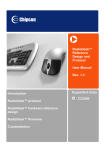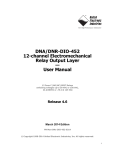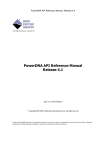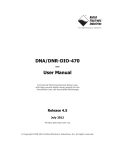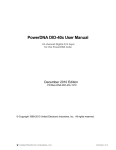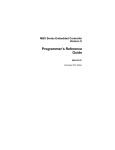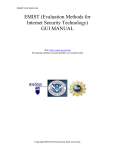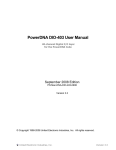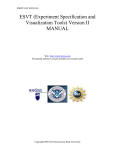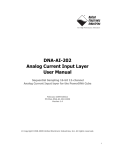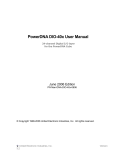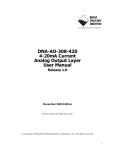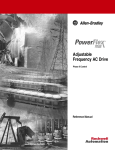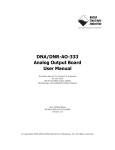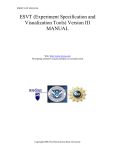Download PowerDNA DIO-416 Solenoid Drive Output Layer User Manual
Transcript
PowerDNA DIO-416 Solenoid Drive Output Layer User Manual 8-Channel, 500 mA, Solenoid/Inductive Load Drive Output Layer Release 1.0 February 2007 Edition PN Man-DNA-DIO-416-0207 © Copyright 1998-2007 United Electronic Industries, Inc. All rights reserved. i No part of this publication may be reproduced, stored in a retrieval system, or transmitted, in any form by any means, electronic, mechanical, by photocopying, recording, or otherwise without prior written permission. Information furnished in this manual is believed to be accurate and reliable. However, no responsibility is assumed for its use, or for any infringement of patents or other rights of third parties that may result from its use. All product names listed are trademarks or trade names of their respective companies. See the UEI website for complete terms and conditions of sale: http://www.ueidaq.com/company/terms.aspx Contacting United Electronic Industries Mailing Address: 611 Neponset Street Canton, MA 02021 U.S.A. For a list of our distributors and partners in the US and around the world, please see http://www.ueidaq.com/partners/ Support: Telephone: Fax: (781) 821-2890 (781) 821-2891 Also see the FAQs and online “Live Help” feature on our web site. Internet Support: Support: Web-Site: FTP Site: [email protected] www.ueidaq.com ftp://ftp.ueidaq.com Product Disclaimer: WARNING! DO NOT USE PRODUCTS SOLD BY UNITED ELECTRONIC INDUSTRIES, INC. AS CRITICAL COMPONENTS IN LIFE SUPPORT DEVICES OR SYSTEMS. Products sold by United Electronic Industries, Inc. are not authorized for use as critical components in life support devices or systems. A critical component is any component of a life support device or system whose failure to perform can be reasonably expected to cause the failure of the life support device or system, or to affect its safety or effectiveness. Any attempt to purchase any United Electronic Industries, Inc. product for that purpose is null and void and United Electronic Industries Inc. accepts no liability whatsoever in contract, tort, or otherwise whether or not resulting from our or our employees' negligence or failure to detect an improper purchase. ii Table of Contents Chapter 1 — Introduction . . . . . . . . . . . . . . . . . . . . . . . . . . . . . . . . . . . . . . . . . . . . . . . . . . . . 1 1.1 1.1.1 1.1.2 1.1.3 1.1.4 Organization of this manual . . . . . . . . . . . . . . . . . . . . . . . . . . . . . . . . . . . . . . . . . . . . . 1 Introduction . . . . . . . . . . . . . . . . . . . . . . . . . . . . . . . . . . . . . . . . . . . . . . . . . . . 1 The DIO-416 Layer . . . . . . . . . . . . . . . . . . . . . . . . . . . . . . . . . . . . . . . . . . . . . 1 Programming with the High-Level API . . . . . . . . . . . . . . . . . . . . . . . . . . . . . . . 1 Programming with the Low-Level API . . . . . . . . . . . . . . . . . . . . . . . . . . . . . . . 1 1.2 The DIO-416 Layer . . . . . . . . . . . . . . . . . . . . . . . . . . . . . . . . . . . . . . . . . . . . . . . . . . . 3 1.3 Features . . . . . . . . . . . . . . . . . . . . . . . . . . . . . . . . . . . . . . . . . . . . . . . . . . . . . . . . . . . 5 1.4 Device Architecture . . . . . . . . . . . . . . . . . . . . . . . . . . . . . . . . . . . . . . . . . . . . . . . . . . . 6 1.5 Layer Connectors and Wiring . . . . . . . . . . . . . . . . . . . . . . . . . . . . . . . . . . . . . . . . . . . 7 1.6 Output Circuits . . . . . . . . . . . . . . . . . . . . . . . . . . . . . . . . . . . . . . . . . . . . . . . . . . . . . . . 9 1.7 Configuring the Circuit Breaker Function. . . . . . . . . . . . . . . . . . . . . . . . . . . . . . . . . . . 10 1.8 Configuring ADC Conversion Speed . . . . . . . . . . . . . . . . . . . . . . . . . . . . . . . . . . . . . 11 1.9 Redundancy . . . . . . . . . . . . . . . . . . . . . . . . . . . . . . . . . . . . . . . . . . . . . . . . . . . . . . . . 11 Chapter 2 — Programming with the High Level API . . . . . . . . . . . . . . . . . . . . . . . . . . . . . 12 2.1 Creating a Session . . . . . . . . . . . . . . . . . . . . . . . . . . . . . . . . . . . . . . . . . . . . . . . . . . . 12 2.2 Configuring the Resource String . . . . . . . . . . . . . . . . . . . . . . . . . . . . . . . . . . . . . . . . 12 2.3 Configuring the Timing . . . . . . . . . . . . . . . . . . . . . . . . . . . . . . . . . . . . . . . . . . . . . . . 13 2.4 Reading Data . . . . . . . . . . . . . . . . . . . . . . . . . . . . . . . . . . . . . . . . . . . . . . . . . . . . . . . 13 2.5 Cleaning-up the Session . . . . . . . . . . . . . . . . . . . . . . . . . . . . . . . . . . . . . . . . . . . . . . 13 Chapter 3 — Programming with the Low-Level API . . . . . . . . . . . . . . . . . . . . . . . . . . . . . . 14 3.1 Code Example . . . . . . . . . . . . . . . . . . . . . . . . . . . . . . . . . . . . . . . . . . . . . . . . . . . . . . 14 Appendix A — Accessories . . . . . . . . . . . . . . . . . . . . . . . . . . . . . . . . . . . . . . . . . . . . . . . . . . 19 Index . . . . . . . . . . . . . . . . . . . . . . . . . . . . . . . . . . . . . . . . . . . . . . . . . . . . . . . . . . . . . . . . . . . 20 iii Table of Figures Chapter 1 — Introduction . . . . . . . . . . . . . . . . . . . . . . . . . . . . . . . . . . . . . . . . . . . . . . . . . . . 1 1-1 A DNA-DIO-416 Digital I/O Layer ..................................................................................4 1-2 DNA-DIO-416 Device Architecture ................................................................................6 1-3 DB-37 I/O Connector Pinout ..........................................................................................7 1-4 Physical Layout of DNA-DIO-416 Layer Board ..............................................................8 1-5 Diagram of DNA-DIO-416 Layer Position Jumper Settings ...........................................8 1-6 Typical Output Circuit Diagram – High-Low Pair ...........................................................9 1-7 Typical Output Circuit Diagram – High-Side ................................................................10 1-8 Typical Output Circuit Diagram – Low-Side .................................................................10 Chapter 2 — Programming with High Level API . . . . . . . . . . . . . . . . . . . . . . . . . . . . . . . . 12 None Chapter 3 — Programming with Low Level API . . . . . . . . . . . . . . . . . . . . . . . . . . . . . . . . . 14 None Appendix A . . . . . . . . . . . . . . . . . . . . . . . . . . . . . . . . . . . . . . . . . . . . . . . . . . . . . . . . . . . . . . . 19 None iv DNA-DIO-416 Layer Chapter 1 Introduction Chapter 1 Introduction This document outlines the feature set and use of the DNA-DIO-416 digital output layer when used with the PowerDNA I/O Cube. 1.1 Organization This PowerDNA DIO-416 User Manual is organized as follows: of this manual 1.1.1 Introduction This chapter provides an overview of PowerDNA DNA-DIO-416 Solenoid/ Inductive Load Drive Output board features, accessories, and what you need to get started. 1.1.2 The DIO-416 Layer This chapter provides an overview of the device architecture, connectivity, and logic of the DNA-DIO-416 layer. 1.1.3 Programming with the High-Level API This chapter provides a general description of the how to create a session, configure the session for solenoid drive/output, and format relevant data. 1.1.4 Programming This chapter describes Low-level API commands for configuring and using the DNA-DIO-416 layer and contains an example of code written for a typical with the Low-Level API application. Appendix A. Accessories This appendix describes the accessories available for use with the DNA-DIO-416 layer. Index This is an alphabetical listing of the topics covered in this manual. © Copyright 2006 all rights reserved United Electronic Industries, United Electronic Industries, Inc. Tel: 781-821-2890 Inc. Tel: 781-821-2890 www.ueidaq.com Date: 02. 14.Printed 2007 02. 14. 2007 Vers:0.5 1.0 File: DNA-DIO-416 Fax: 781-821-2891 Chap1.fm 1 DNA-DIO-416 Layer Chapter 1 Introduction Manual Conventions To help you get the most out of this manual and our products, please note that we use the following conventions: Tips are designed to highlight quick ways to get the job done, or reveal good ideas you might not discover on your own. NOTE: Notes alert you to important information. CAUTION! advises you of precautions to take to avoid injury, data loss, and damage to your boards or a system crash. Text formatted in bold typeface generally represents text you should be entered verbatim. For instance, it can represent a command, as in the following example: “You can instruct users how to run setup using a command such as setup.exe.” Before plugging any I/O connector into the Cube or Layer, be sure to remove power from all field wiring. Failure to do so may cause severe damage to the equipment. © Copyright 2006 all rights reserved United Electronic Industries, United Electronic Industries, Inc. Tel: 781-821-2890 Inc. Tel: 781-821-2890 www.ueidaq.com Date: 02. 14.Printed 2007 02. 14. 2007 Vers:0.5 1.0 File: DNA-DIO-416 Fax: 781-821-2891 Chap1.fm 2 DNA-DIO-416 Layer Chapter 1 Introduction 1.2 The DIO-416 Layer The DNA-DIO-416 is an 8-channel Digital Output Layer designed for driving solenoids, motors, or other inductive loads attached to a PowerDNA Cube. It has 8 digital outputs controlled by field-effect transistors (FETs) that can be configured to provide output control for 8 channels on both high and low sides of the load, or 8 channels each on just the high or low sides. The board has redundant support FETs on every channel and also provides overvoltage (kickback) and overcurrent protection on every channel. Output current monitors (0.5% accuracy) can be configured to trigger automatic shutdown on overload, detect short/open output circuits, and to confirm the state of every channel. The maximum current drive is 500 mA per channel. You can set the current and duration of an overload (as short as 10 mS) required to shut down each channel. The DNA-DIO-416 layer requires an external 10-55V power source. The technical specifications for the DIO-416 layer are listed in Table 1-1. Table 1-1 DNA-DIO-416 Technical Specifications p Number of channels Drive Capacity Output Rate Output Protection Circuit Breaker: Current limit Closing time Current Monitor: Resolution ADC Speed Sense Resitor Over-current Limit Under-current Limit Accuracy Noise Interrupts (maskable) Limit Override Power Requirements (VCC) Power Consumption Isolation Physical Dimensions Operating Temp. Range Operating Humidity © Copyright 2006 all rights reserved United Electronic Industries, United Electronic Industries, Inc. Tel: 781-821-2890 Inc. 16 digital outputs (8 high- and 8 low-side) 500mA per channel continuous max; 1A per channel max peak (1 sec max) 125Hz per channel max ±90V peak; 2kV ESD 50mA - 1A (user-programmable) 200-500ms (autorestart) 24-bit ADC 0.6 to 293 Hz 0.025Ý 0-2A 0-2A 0.5% of full scale < 1mA 2 per channel (over/under-current) programmable per channel 10-55V external source 1.5W no load, 3.5W at max load 350Vrms 3.875” x 3.875” (98 x 98 mm) Tested -40 to 85°C 90%, non-condensing Tel: 781-821-2890 www.ueidaq.com Date: 02. 14.Printed 2007 02. 14. 2007 Vers:0.5 1.0 File: DNA-DIO-416 Fax: 781-821-2891 Chap1.fm 3 DNA-DIO-416 Layer Chapter 1 Introduction Figure 1-1 is a photo of the DNA-DIO-416 Layer board IRQ Jumpers (Do not change) Layer Position Jumpers (see Figure 1-5) 120-pin DNA bus connector Power Connector DB-37 (female) 37-pin I/O connector Figure 1-1 A DNA-DIO-416 Digital I/O Layer © Copyright 2006 all rights reserved United Electronic Industries, United Electronic Industries, Inc. Tel: 781-821-2890 Inc. Tel: 781-821-2890 www.ueidaq.com Date: 02. 14.Printed 2007 02. 14. 2007 Vers:0.5 1.0 File: DNA-DIO-416 Fax: 781-821-2891 Chap1.fm 4 DNA-DIO-416 Layer Chapter 1 Introduction 1.3 Features The main features of the PowerDNA DNA-DIO-416 Solenoid Drive Output Layer are: • • • • • • • • • • • • • • • • • • • • • © Copyright 2006 all rights reserved United Electronic Industries, United Electronic Industries, Inc. Tel: 781-821-2890 Inc. 16 digital outputs configured either as 8 high-low pairs or 8 High-side and 8 Low-Side channels 500 mA per channel maximum current drive 125 Hz per channel maximum output rate Ideal for driving solenoids, motors, or other inductive loads FET transistors for high- and low-side outputs Inductive load kickback protection on every high-low channel pair Resettable overload circuit breaker function on every channel Output current monitoring (0.5% accuracy, 24-bit resolution) for short/ open circuit and output state detection Requires external 10-55Vpower source (1.5W no load, 4.5W max load) “Power Good” monitor – indicates VCC >= 10V Programmable enable DC/DC control (emergency shutoff) Redundancy support diodes on every channel Over- and under-current monitoring with programmable delay FET circuit breaking on every channel Auto-enable option, selectable per channel, attempts to restore disabled channel Interrupt on over- and under-current conditions Current monitoring user-programmable from 50mA - 2A Default limit is 1000 mA, default disconnect time is 10-15mS Layer survives output circuit shorts with impedances of 3 ohms or more SYNC interface support Clock output/trigger input provided Guaranteed output OFF state on initial power-up, external power OFF, internal power OFF, and overload detected Tel: 781-821-2890 www.ueidaq.com Date: 02. 14.Printed 2007 02. 14. 2007 Vers:0.5 1.0 File: DNA-DIO-416 Fax: 781-821-2891 Chap1.fm 5 DNA-DIO-416 Layer Chapter 1 Introduction The DNA-DIO-416 Layer has 8 digital outputs (8-high/low channels configured as current sources). There are two sigma-delta ADCs, one for high-side circuits, and one for low-side circuits, that run independently. A block diagram of the board is shown in Figure 1-2. HIGH-SIDE OUTPUTS DOut (8) FET Transistor DOut (8) FET Transistor Overvoltage Protection Digital I/O Connector Power In DGND Current Monitor Current Monitor Sense Resistor 32-bit 66-MHz bus DC/DC Control Logic Sense Resistor VCC Optical Isolation Block Diagram: Optoisolators Device Architecture Optoisolators 1.4 DC/DC LOW-SIDE OUTPUTS Optoisolator Figure 1-2 DNA-DIO-416 Device Architecture Note that the I/O part of the layer is isolated from the logic interface by isolation transformers and that overload protection is provided on all inputs and outputs. © Copyright 2006 all rights reserved United Electronic Industries, United Electronic Industries, Inc. Tel: 781-821-2890 Inc. Tel: 781-821-2890 www.ueidaq.com Date: 02. 14.Printed 2007 02. 14. 2007 Vers:0.5 1.0 File: DNA-DIO-416 Fax: 781-821-2891 Chap1.fm 6 DNA-DIO-416 Layer Chapter 1 Introduction 1.5 Layer Connectors and Wiring The pinout of the DB-37 37-pin female connector for the DNA-DIO-416 Layer board is shown in Figure 1-3. DB-37 (female) 37-pin connector: VCC DGND VCC VCC VCC VCC RESERVED DOUT15 DOUT14 DOUT12 DOUT11 DOUT9 DOUT8 DOUT6 DOUT5 DOUT3 DOUT2 DOUT0 37 36 35 34 33 32 31 30 29 28 27 26 25 24 23 22 21 20 19 18 17 16 15 14 13 12 11 10 9 8 7 6 5 4 3 2 1 VCC VCC DGND VCC DGND VCC DGND RESERVED DGND DOUT13 DGND DOUT10 DGND DOUT7 DGND DOUT4 DGND DOUT1 DGND High-Side: DOUT0, DOUT2, DOUT4, DOUT6, DOUT8, DOUT10, DOUT12, DOUT14 Low-Side: DOUT1, DOUT3, DOUT5, DOUT7, DOUT9, DOUT11, DOUT13, DOUT15 Note: Connect external power source to VCC pins. All VCC and DGND pins should be used to supply external power. Figure 1-3 DB-37 I/O Connector Pinout Note that the DIO-416 outputs are numbered from DOut0 through DOut15. Also note the location of the nine VCC pins. Power must be supplied to the layer by connecting an external 10-55V power source directly to the VCC pins or indirectly through the VCC pins on a DNA-STP-37 terminal panel connected to the 37-pin I/O connector on the board. When power is provided to the layer, the RDY LED on the PowerDNA Cube turns on. When no power is supplied, the RDY LED is off, and the DNA-DIO-416 layer cannot operate. The only valid channel pairs are Channels 1and 2, 2 and 3, 4 and 5, 6 and 7, 8 and 9, 10 and 11, 12 and 13, 14 and 15. Use of any other channel pair connections may cause severe damage to the equipment because kickback protection diodes will not be present. Before plugging any I/O connector into the Cube or Layer, be sure to remove power from all field wiring. Failure to do so may cause severe damage to the equipment. The board does not have reverse polarity protection because of space constraints. To prevent damage, use extreme caution in connecting power to the layer. © Copyright 2006 all rights reserved United Electronic Industries, United Electronic Industries, Inc. Tel: 781-821-2890 Inc. Tel: 781-821-2890 www.ueidaq.com Date: 02. 14.Printed 2007 02. 14. 2007 Vers:0.5 1.0 File: DNA-DIO-416 Fax: 781-821-2891 Chap1.fm 7 DNA-DIO-416 Layer Chapter 1 Introduction 1 2 3 4 5 6 7 8 9 10 11 12 13 14 15 16 DNA 120-pin Bus Connector J1 Factory Use Only See Figure 1-5 for jumper locations for setting layer position. Power Connector DB-37 I/O Connector External Circuits Figure 1-4. Physical Layout of DNA-DIO-416 Layer Board 1.5.0.1 Jumper Settings A diagram of the jumper block is shown in Figure 1-5. To set the layer position jumpers, place jumpers as shown in Figure 1-5. NOTE: Since all layers are assembled in Cubes before shipment to a customer, you should never have to change a jumper setting unless you change a layer from one position to another in the field. Jx Pins I/O 1 Layer’s Position as marked on the Faceplate* I/O 2 I/O 3 I/O 4 I/O 5 I/O 6 9-10 11-12 13-14 15-16 * All I/O Layers are sequentially enumerated from top to the bottom of the Cube - Open - Closed Figure 1-5. Diagram of DNA-DIO-416 Layer Position Jumper Settings © Copyright 2006 all rights reserved United Electronic Industries, United Electronic Industries, Inc. Tel: 781-821-2890 Inc. Tel: 781-821-2890 www.ueidaq.com Date: 02. 14.Printed 2007 02. 14. 2007 Vers:0.5 1.0 File: DNA-DIO-416 Fax: 781-821-2891 Chap1.fm 8 DNA-DIO-416 Layer Chapter 1 Introduction 1.6 Output Circuits Each output circuit is built as shown in Figure 1-6. +50VDC To ADC (Current Monitor) RH0 HSCH1 HSCH1 240 CA0 0.022uF CB0 0.022uF HSCH0 -5VI HSCH0 RSH0 0.025 Ohm/WSL0805R0250FEA RA0 240 RC0 D_OUT0 D_OUT0 3 100K Q0B 4 RI0 RE0 10K FDS4559/NC(Q2) FET 56K 5 6 DA0 DOUT0 DOUT0 DFLS160 1A/60V Redundancy Support Diodes User Load DB0 DFLS160 1A/60V DC0 DOUT1 DOUT1 7 8 DFLS160 1A/60V FET Q0A FDS4559/PC(Q1) D_OUT1 D_OUT1 RJ0 RF0 56K 2 10K 1 RD0 100K LSCH1 To ADC (Current Monitor) LSCH1 RB0 240 CC0 1uF DGND LSCH0 CD0 1uF LSCH0 RSL0 0.025 Ohm/WSL0805R0250FEA RG0 240 DGND Figure 1-6 Typical Output Circuit Diagram – High-Low Pair Because of inherent imbalances in components in the circuit of Figure 1-6, a small current is always flowing from VCC to ground through the 0.025 ohm sense resistors. This produces a voltage that is monitored by the two current sensing ADCs. If the current falls below a programmed minimum, this indicates a possible fault such as an open circuit. An interrupt is then enabled. Similarly, an overcurrent in the ON state indicates a short or overload condition, which generates an interrupt and can cause the circuit to be shut down, if so configured. Figure 1-7 shows a typical High-Side output circuit. Its function is similar to that of Figure 1-6, except that it only uses the high-side FET. Figure 1-7 shows a typical Low-Side output circuit, using only the low-side FET. © Copyright 2006 all rights reserved United Electronic Industries, United Electronic Industries, Inc. Tel: 781-821-2890 Inc. Tel: 781-821-2890 www.ueidaq.com Date: 02. 14.Printed 2007 02. 14. 2007 Vers:0.5 1.0 File: DNA-DIO-416 Fax: 781-821-2891 Chap1.fm 9 ,(-**#',('&,(* DNA-DIO-416 Layer Chapter 1 Introduction 1 * '+&+,(* -,&$% -,0 #"-'" '!0&'$ -))(*,&("#+ #.#*+# -**#', *(,#!,&(' +#* ( " -,1 DGND Figure 1-7. Typical Output Circuit Diagram – High-Side -,0 10-55V DC #"-'" '!0&'$ -))(*,&("#+ #.#*+# -**#', *(,#!,&(' +#* ( " -,1 * '+&+,(* -,(/ ,(-**#',('&,(* 1 Figure 1-8 Typical Output Circuit Diagram – Low-Side 1.7 Configuring the Circuit Breaker Function © Copyright 2006 all rights reserved United Electronic Industries, United Electronic Industries, Inc. Tel: 781-821-2890 Inc. Referring to the circuit of Figure 1-6, the voltages from both high and low side current sensing resistors are fed to the two ADCs. The ADC outputs are then processed in the logic to perform a virtual circuit breaker function. The outputs are first compared to preset limits. If they exceed the limits, the FETs are turned OFF and the output circuit is shut down. Depending on how the channel is configured, the shutdown may either be immediate or delayed by a programmable time or by a cumulative number of detected faults. Tel: 781-821-2890 www.ueidaq.com Date: 02. 14.Printed 2007 02. 14. 2007 Vers:0.5 1.0 File: DNA-DIO-416 Fax: 781-821-2891 Chap1.fm 10 DNA-DIO-416 Layer Chapter 1 Introduction The circuit breaker function can also be configured for either User Re-enable (default) or for Auto Re-enable. The user-re-enable mode requires a write operation to re-enable output on the disabled channel. The auto-re-enable mode attempts to restore the channel after a 1 second (default) delay. If an overcurrent is detected on restart, the channel is disabled again and the re-enable attempt is repeated. The re-enable time interval is user programmable. 1.8 Configuring ADC Conversion Speed The speed and resolution of the ADC are user-programmable in the range from 0.6 to 293 Hz. Refer to the section marked “optional” in the code example in Chapter 3, page 17, for more detail on setting ADC speed and resolution. The default value for the ADC speed is 110 Hz, which corresponds to 13 Hz per channel because of overhead. Slower speed produces more accurate results but increases circuit breaker disconnect time, as shown in the table below. Circuit minimum breaker reaction, ms Measured Nominal channel- Actual aggregate channel ADC speed,Hz delay, uS speed, Hz 3520 1760 880 440 220 110 55 27.5 13.75 6.875 634 912 1470 2600 4860 9400 18300 36600 72000 148000 1577.29 1096.49 680.27 384.62 205.76 106.38 54.64 27.32 13.89 6.76 VIn full scale,mV LSB, full scale mV/LSB uV/LSB nV/LSB 1.9 Per channel rate, Hz 50 8388608 5.96046E-06 0.005960464 5.960464478 Redundancy 197.16 137.06 85.03 48.08 25.72 13.30 6.83 3.42 1.74 0.84 Measured Measured Measured 4 3 2 noise, uV noise, mA Immediate consecutive consecutive consecutive noise, Ain LSB, p-p Vin samples samples samples decision 5.07 7.30 11.76 20.80 38.88 75.20 146.40 292.80 576.00 1184.00 10.14 14.59 23.52 41.60 77.76 150.40 292.80 585.60 1152.00 2368.00 Shunt resistor, Ohm Full scale current, uA uA/LSB 15.22 21.89 35.28 62.40 116.64 225.60 439.20 878.40 1728.00 3552.00 20.29 29.18 47.04 83.20 155.52 300.80 585.60 1171.20 2304.00 4736.00 3857 3584 2560 2048 896 768 592 544 256 200 22.98951 21.3623 15.25879 12.20703 5.340576 4.577637 3.528595 3.242493 1.525879 1.192093 5.481127 5.09317 3.637979 2.910383 1.273293 1.091394 0.841283 0.77307 0.363798 0.284217 0.025 2000000 Note: typical reaction of the circuit breaker is ~ 50% longer then minimal 0.23841858 Maximum reaction time is 2x minimal Increased system reliability is ensured by using the High-Low Side Pair circuit for a given channel as illustrated in Figure 1-6. As shown in the figure, a malfunction in one the FETs or side circuits will not prevent the other FET from disabling the circuit when needed. The current sensing in the good side still functions and the circuit breaker function will still operate safely. Note that this feature is not valid when High-Side only (Figure 1-7) or Low-Side (Figure 1-8) only circuits are configured. © Copyright 2006 all rights reserved United Electronic Industries, United Electronic Industries, Inc. Tel: 781-821-2890 Inc. Tel: 781-821-2890 www.ueidaq.com Date: 02. 14.Printed 2007 02. 14. 2007 Vers:0.5 1.0 File: DNA-DIO-416 Fax: 781-821-2891 Chap1.fm 11 DNA-DIO-416 Layer Chapter 2 Programming with the High Level API Chapter 2 Programming with the High Level API This section describes how to control the PowerDNA DIO-416 with UEIDAQ’s high-level API, called Framework. Framework is object oriented; its objects can be manipulated in the same manner from a wide range of development environments such as Visual C++, Visual Basic or LabVIEW. The following section focuses on the C++ API, but the concept is the same no matter what programming language you use. Please refer to the “UeiDaq Framework User Manual” to get more information on using other programming languages. 2.1 Creating a Session The Session object controls all operations on your PowerDNA device. Therefore, the first task is to create a session object: CUeiSession session; 2.2 Configuring Framework uses resource strings to select which device, subsystem, and chanthe Resource nels to use within a session. The resource string syntax is similar to a web URL: String <device class>://<IP address>/<Device Id>/<Subsystem><Channel list> For PowerDNA, the device class is pdna. As an example, the following resource string selects digital output channels 0,1,2,3 on device 1 at IP address 192.168.100.2: "pdna://192.168.100.2/Dev1/D0:3" NOTE: In Framework, a digital channel corresponds to a physical port on the device. Note that you cannot configure a session only to access a subset of lines within a digital port. //Configure session to write to port 0 on device 1 do_session.CreateDOChannel("pdna://192.168.100.2/Dev1/Do0"); NOTE: Sessions are unidirectional. If your device has both input and output ports or has bidirectional ports, you need to configure two sessions: one for input and one for output. © Copyright 2006 all rights reserved United Electronic Industries, United Electronic Industries, Inc. Tel: 781-821-2890 Inc. Tel: 781-821-2890 www.ueidaq.com Date: 02. 14.Printed 2007 02. 14. 2007 Vers:0.5 1.0 File: DNA-DIO-416 Fax: 781-821-2891 Chap2.fm 12 DNA-DIO-416 Layer Chapter 2 Programming with the High Level API 2.3 Configuring the Timing You can configure the DIO-416 to run in simple mode (point by point), buffered mode (ACB mode), or Dmap mode. In simple mode, the delay between samples is determined by software on the host computer. In buffered mode, the delay between samples is determined by the DIO-416 onboard clock. The following sample shows how to configure the simple mode. Please refer to the “UeiDaq Framework User’s Manual” to learn how to use the other timing modes. di_session.ConfigureTimingForSimpleIO(); 2.4 Reading Data Reading data from the DIO-416 is done by using a reader object. The following sample code shows how to create a scaled reader object and use it to read samples. // Create a reader and link it to the session’s //stream CUeiDigitalReader reader(di_session.GetDataStream()); // read one scan, the buffer must be big enough to //contain one value per channel uInt16 data; reader.ReadSingleScan(&data); 2.5 Cleaning-up the Session The session object cleans itself up when it goes out of scope or when it is destroyed. However, you can manually clean up the session (to reuse the object with a different set of channels or parameters) by entering: do_session.CleanUp(); © Copyright 2006 all rights reserved United Electronic Industries, United Electronic Industries, Inc. Tel: 781-821-2890 Inc. Tel: 781-821-2890 www.ueidaq.com Date: 02. 14.Printed 2007 02. 14. 2007 Vers:0.5 1.0 File: DNA-DIO-416 Fax: 781-821-2891 Chap2.fm 13 DNA-DIO-416 Layer Chapter 3 Programming with the Low-Level API Chapter 3 3.1 Programming with the Low-Level API Code Example The following is an example of code used for a DNA-DIO-416 Layer. //================================================================================== // // NAME: Sample416.c // // DESCRIPTION: // // Test DIO-416 specific commands // // NOTES: This example utilizes a single DIO-416 layer. // // -------------------------------------------------------------------------------// // Copyright (C) 2006 United Electronic Industries, Inc. // All rights reserved. // United Electronic Industries Confidential Information. // //============================================================================ #include <stdio.h> #include <signal.h> #ifdef _WIN32 #include <winsock2.h> #include <conio.h> #else #include <netinet/in.h> #include <unistd.h> #endif // _WIN32 #include "PDNA.h" /********************************* IMPORTANT NOTE ************************* Before this example can be tested on your network, you have to set up IP address of the cube (IOM_IPADDR) and device number (DEVN) of the layer you intend to use. Make sure that IP address of the cube lies within network mask defined in your Ethernet interface settings. **************************************************************************/ /* BEGIN CUSTOM CONFIGURATION */ #define IOM_IPADDR0 #define DEVN #define TOTALSCANS "192.168.100.2" 0 0 /* END CUSTOM CONFIGURATION */ #define TIMEOUT_DELAY #define RETRY_ATTEMPTS 2000 10 // milli seconds // END Customizing defines #define EVENT_TIMEOUT © Copyright 2006 all rights reserved United Electronic Industries, United Electronic Industries, Inc. Tel: 781-821-2890 Inc. 500 // how long to wait for events to happen Tel: 781-821-2890 www.ueidaq.com Date: 02. 14.Printed 2007 02. 14. 2007 Vers:0.5 1.0 File: DNA-DIO-416 Fax: 781-821-2891 Chap3.fm 14 DNA-DIO-416 Layer Chapter 3 Programming with the Low-Level API #define UPDATE_PERIOD 50 int stop; // -// Handler for SIGINT // void handler(int sig) { stop = 1; } // // ----------------- main routine ----------------------------// #define OVERCURRENTLIMIT (0.505) #define UNDERCURRENTLIMIT (-0.01) int main(int argc, char* argv[]) { int error_found = 0; int hd0 = 0; int i, ret; pDQE pDqe = NULL; pDQBCB pBcb = NULL; uint32 dataout,datain; DQRDCFG *DQRdCfg = NULL; int timeout = EVENT_TIMEOUT; int datarcv = 0; int packetlost = 0; int errorsallowed = RETRY_ATTEMPTS; // maximum errors allowed at a time DQDIO416DATAIN data416; DQDIO416DATAOUT data416out = {0,0,0,0,0,0,0,0,0,0,0,0,0,0,0,0,0,0}; double float416[DQ_DIO416_CHAN]; #ifndef _WIN32 DqInitDAQLib(); #endif signal(SIGINT, handler); // open communication with IOM and receive IOM crucial identification data if ((ret = DqOpenIOM(IOM_IPADDR0, DQ_UDP_DAQ_PORT, TIMEOUT_DELAY, &hd0, &DQRdCfg)) < 0) { printf("\nError In Initializing Communication with IOM"); return -1; } if (DQRdCfg == NULL) { printf("\nError in receiving the response for Echo Command"); error_found = 1; goto finish_up; } printf("ipaddr = %d.%d.%d.%d\n", (DQRdCfg->ipaddr & 0xff000000)>>24, (DQRdCfg->ipaddr & 0x00ff0000)>>16, © Copyright 2006 all rights reserved United Electronic Industries, United Electronic Industries, Inc. Tel: 781-821-2890 Inc. Tel: 781-821-2890 www.ueidaq.com Date: 02. 14.Printed 2007 02. 14. 2007 Vers:0.5 1.0 File: DNA-DIO-416 Fax: 781-821-2891 Chap3.fm 15 DNA-DIO-416 Layer Chapter 3 Programming with the Low-Level API (DQRdCfg->ipaddr & 0x0000ff00)>>8, (DQRdCfg->ipaddr & 0x000000ff)); printf("model = %04x\n", DQRdCfg->model); printf("sernum = %07d\n", DQRdCfg->sernum); printf("mfgdate = %x/%x/%x\n", (DQRdCfg->mfgdate (DQRdCfg->mfgdate (DQRdCfg->mfgdate printf("caldate = %x/%x/%x\n", (DQRdCfg->caldate (DQRdCfg->caldate (DQRdCfg->caldate & & & & & & 0xff000000)>>24, 0xff0000)>>16, 0xffff)); 0xff000000)>>24, 0xff0000)>>16, 0xffff)); for (i = 0; i < DQ_MAXDEVN; i++) { if (DQRdCfg->devmod[i]) { printf("Model: %x Option: %x\n", DQRdCfg->devmod[i], DQRdCfg->option[i]); } else { break; } } for (i = 0; i < 16; i++) { if ((ret = DqAdv416SetLimit(hd0, DEVN, i, OVERCURRENTLIMIT)) < 0) { printf("\nError in DqAdv416SetLimit()"); error_found = 1; goto finish_up; } } for (i = 16; i < 32; i++) { if ((ret = DqAdv416SetLimit(hd0, DEVN, i, UNDERCURRENTLIMIT)) < 0) { printf("\nError in DqAdv416SetLimit()"); error_found = 1; goto finish_up; } } // -----------------------------------------------------------------------// OPTIONAL PART - get all possible data from the 416 if ((ret = DqAdv416GetAll(hd0, DEVN, &data416, (double*) float416)) < 0) { printf("\nError in DqAdv416GetAll()"); error_found = 1; goto finish_up; } printf("cfg=%08x\n", data416.cfg);//disconnection mode configuration printf("port0out=%08x\n", data416.port0out); //last value written to the output printf("adcsts=%08x\n", data416.adcsts); // ADC status and speed selected printf("port0ocs=%08x\n", data416.port0ocs); // Overcurrent status printf("port0ucs=%08x\n", data416.port0ucs); // Undercurrent status printf("rdcnt=%08x\n", data416.rdcnt);//# of successive reads before failure detected printf("adcdata0=%08x\n", data416.adcdata0); // User-selected ADC conversion result, // low-side printf("adcdata1=%08x\n", data416.adcdata1); // User-selected ADC conversion result, // high-side printf("disdiv=%08x\n", data416.disdiv); // Divider for re-enable circuitry printf("dout=%08x\n", data416.dout);// Actual values on the outputs, low side //inverted © Copyright 2006 all rights reserved United Electronic Industries, United Electronic Industries, Inc. Tel: 781-821-2890 Inc. Tel: 781-821-2890 www.ueidaq.com Date: 02. 14.Printed 2007 02. 14. 2007 Vers:0.5 1.0 File: DNA-DIO-416 Fax: 781-821-2891 Chap3.fm 16 DNA-DIO-416 Layer Chapter 3 Programming with the Low-Level API for (i=0; i<DQ_DIO416_CHAN; i++) { printf("ocl[%02d]=%08x ", i, data416.ocl[i]); // Overcurrent limit printf("ucl[%02d]=%08x ", i, data416.ucl[i]); // Undercurrent limit printf("adc[%02d]=%08x ", i, data416.adc[i]); // Raw ADC Value printf("cur[%02d]=%6d uA\n",i, data416.cur[i]); // uA ADC Value } // -----------------------------------------------------------------------// OPTIONAL PART - set additional configuration parameters on 416 // set fastest speed possible keeping current settings on timing data416out.adcspdset = 1; data416out.adcspd = data416.adcsts & 0xFFF00000 | DQ_L416_ADCSPD_190; // change number of "failed" reads prior to break data416out.rdcntset = 1; data416out.rdcnt = 2; if (ret = DqAdv416SetAll(hd0, DEVN, &data416out) < 0) { printf("\nError in DqAdv416GetAll()"); error_found = 1; goto finish_up; } while (!stop) { datarcv++; printf("\nCycle #%d", datarcv); // Get status of the disabled channels first // because channels will be re-enabled when updated if ((ret = DqAdv40xRead(hd0, DEVN, &datain)) < 0) { printf("\nError in DqAdv40xRead()"); error_found = 1; goto finish_up; } printf(" DOUT status = 0x%08x", datain); dataout = datarcv % 16 * 0x001111; printf(" dataout = 0x%04x", dataout); // Write digital outputs if ((ret = DqAdv40xWrite(hd0, DEVN, dataout)) < 0) { printf("\nError in DqAdv40xWrite()"); error_found = 1; goto finish_up; } Sleep(500); /* limit the number of loops if TOTALSCANS != 0 */ if (TOTALSCANS && (datarcv >= TOTALSCANS)) { stop = 1; } } printf("\n"); finish_up: if (hd0) { DqCloseIOM(hd0); © Copyright 2006 all rights reserved United Electronic Industries, United Electronic Industries, Inc. Tel: 781-821-2890 Inc. Tel: 781-821-2890 www.ueidaq.com Date: 02. 14.Printed 2007 02. 14. 2007 Vers:0.5 1.0 File: DNA-DIO-416 Fax: 781-821-2891 Chap3.fm 17 DNA-DIO-416 Layer Chapter 3 Programming with the Low-Level API } #ifndef _WIN32 DqCleanUpDAQLib(); #endif if (error_found) { return -1; } else { return 0; } } © Copyright 2006 all rights reserved United Electronic Industries, United Electronic Industries, Inc. Tel: 781-821-2890 Inc. Tel: 781-821-2890 www.ueidaq.com Date: 02. 14.Printed 2007 02. 14. 2007 Vers:0.5 1.0 File: DNA-DIO-416 Fax: 781-821-2891 Chap3.fm 18 DNA-DIO-416 Layer Appendix A. Accessories The following cables and STP boards are available for the DIO-416 layer. DNA-CBL-37 A 3ft, 37-way flat ribbon cable that connects the layer to a terminal panel. DNA-STP-37 37-way screw terminal panel. © Copyright 2006 all rights reserved United Electronic Industries, Inc. Tel: 781-821-2890 Date: 02. 14. 2007 Vers: 1.0 File: DNA-DIO-416 Appx.fm 19 Index 20 Index A P ADC Conversion Speed 11 Architecture 6 Photo of DIO-416 4 Physical Layout 8 Pinout 7 Programmin Low-Level API 14 Programming Cleaning-up 13 Configuring resource string 12 Configuring timing 13 Creating a session 12 Reading and Writing Data 13 Programming with high-level API 12 B Block Diagram 6 C Cable(s) 19 Caution 7 Configuring the Circuit Breaker 10 Conventions 2 D Description 3 F R Features 5 Redundancy 11 H S High Level API 12 J Jumper Settings 8 L Layer Position Jumper Settings 8 O Organization 1 Output Circuit Diagram - High/Low Pair 9 Output Circuit Diagram - Low Side 10 Output Circuit Diagram- High Side 10 © Copyright 2006 all rights reserved United Electronic Industries, Inc. Tel: 781-821-2890 Date: 02. 14. 2007 Screw Terminal Panels 19 Specifications 3 Support ii Support email [email protected] ii Support FTP Site ftp //ftp.ueidaq.com ii Support Web Site www.ueidaq.com ii Vers: 1.0 File:DNA-DIO-416IX.fm
























